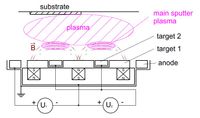Dual Target Magnetron Sputtering
In Direct Ion Beam Sputtering (DIBS) it is a well known effect, that the ion energy of the sputtering ions influences the particle energy of the sputtered target atoms. Earlier [1] and later publications of this [2] show, that the energy distribution of sputtered target atoms is shifted to higher energies by varying the primary ion energy between 250 and 1000 eV. By this way the mean energy of the sputtered particles grows typically from 3 to 6 eV up to 6 to 10 eV, having some influence to the corresponding layer growth. Moreover the of amount and energy of reflected neutral atoms in dependence of the primary ion energy are increased.
This effect is well known in direct ion beam sputtering. The aim of this work is to show, that with a modified magnetron (Double Target Magnetron, DTM) an extended and controlled primary ion energy range up to 1.000 eV like in direct ion beam sputtering can be realized.
The principle of the DTM is shown in cross section. A modified sputter magnetron (Dual Target Magnetron) with two target parts was used. Several target materials had been installed. The sputter plasma was ignited and generated by the DC-generator U1, applied between anode and target 1. The target part (erosion zone, target 2), where most sputtering occurs, was isolated against target 1 and powered by an additional negative voltage U2.
Principle of the Dual Target Magnetron
By this method the energy of the primary argon ions, impinging on target 2, could be varied from 250 up to 1.000 eV . Application of more primary ion energy increases the deposition speed (increased sputter yield) and the energy flux of the particles, coming from target 2. The acceleration of the primary ions occurs at a thin plasma sheet over target 2. It is a nearly collision less ion acceleation without bigger changes at the main plasma.
Dual Target Magnetron in operation (10e-2mbar argon, 80 W)
An actual overview about magnetron sputtering with controlled primary ion energy gives the following presentation:
More information can be found at our poster presentations at the PSE 2024 - Plasma Surface Engineering - 2024, Erfurt:
References
[1] Stuart R.V., Wehner G.K., J. Appl. Phys., 35, 1819, (1964),
[2] M. Stepanova, S.K. Dew, “Estimates of differential sputtering yields for deposition applications”, J. Vac. Sci. Technolog. A 19, 2805, (2001),


